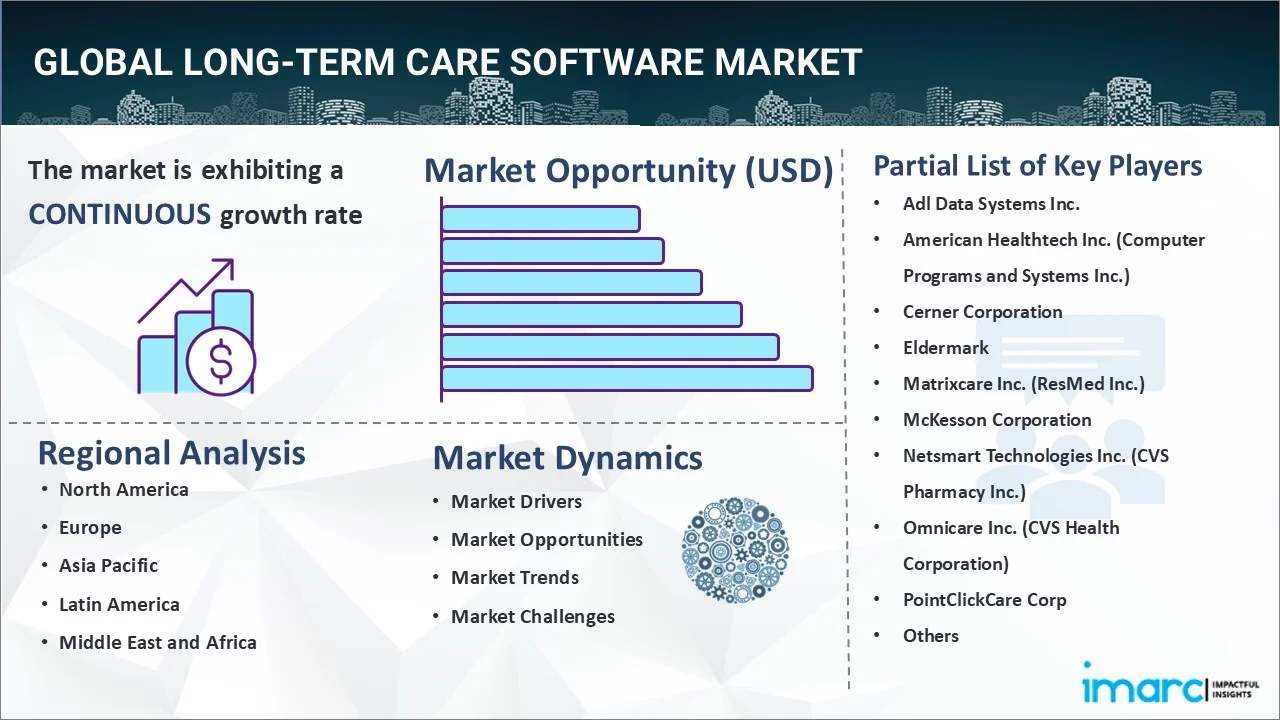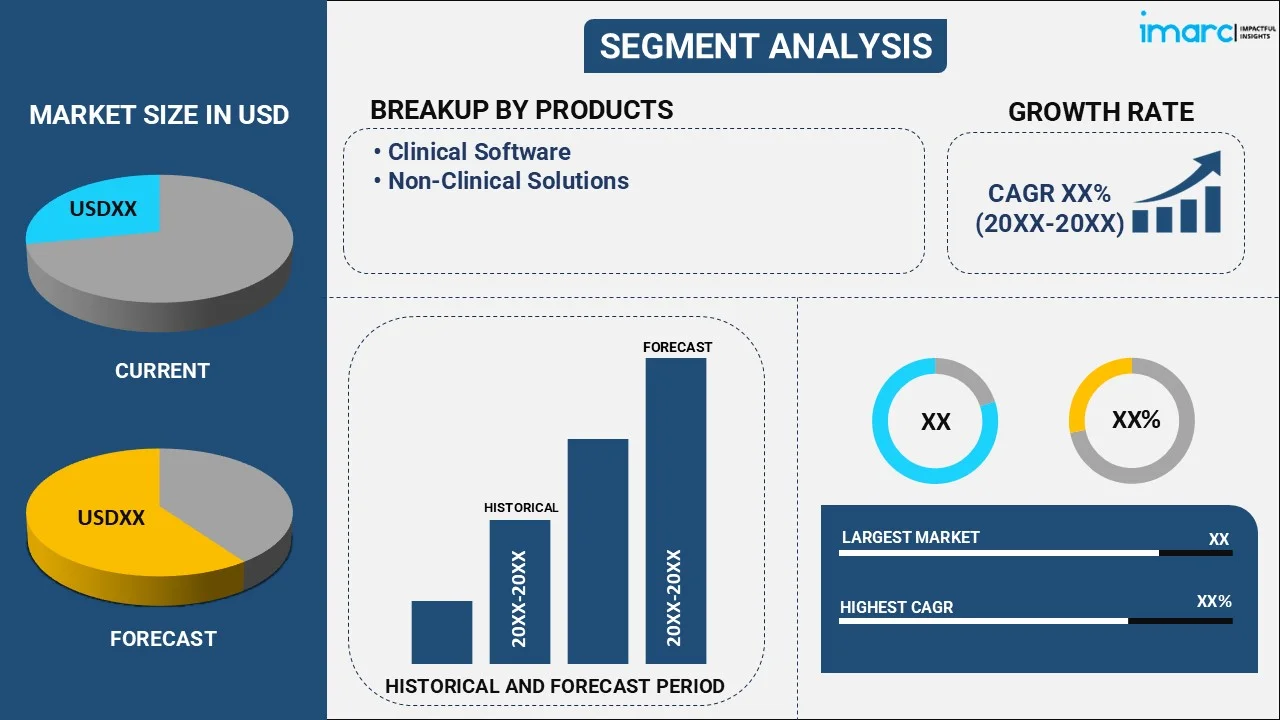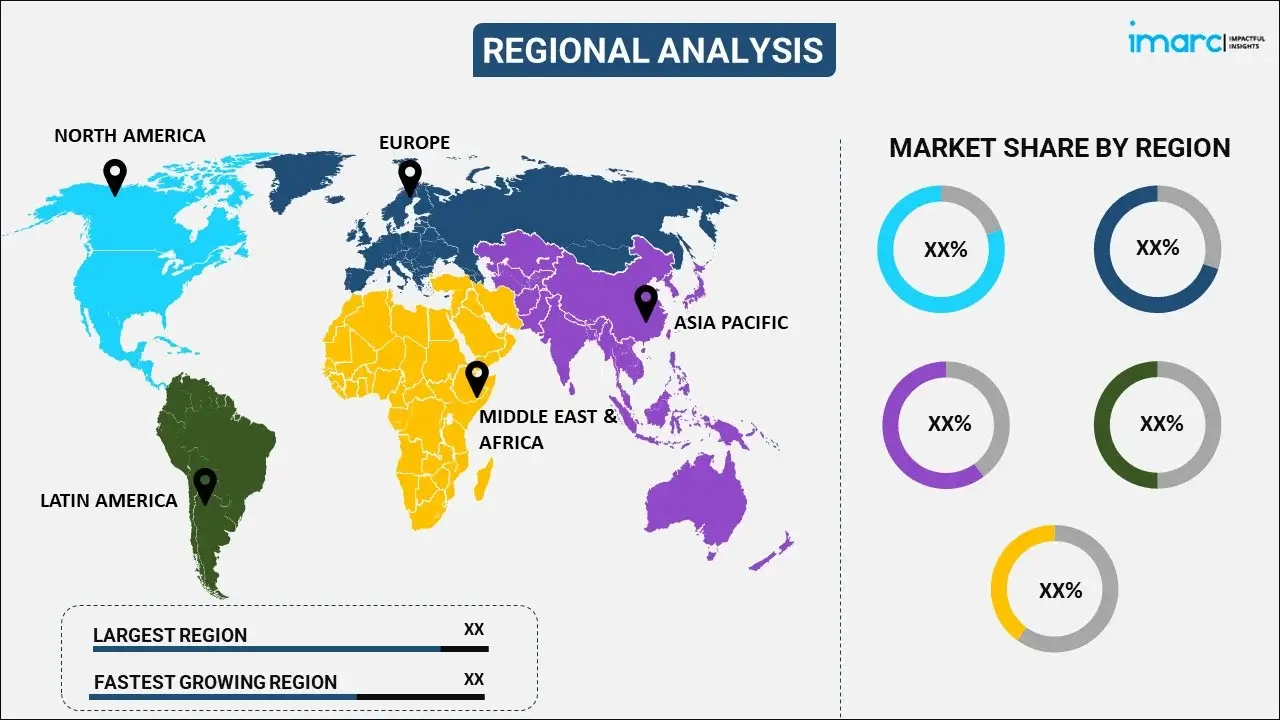
Long-term Care Software Market Report by Product (Clinical Software, Non-Clinical Solutions), Deployment Type (Web-based, On-premises, Cloud-based), End User (Home Care Agencies, Hospice Care Facilities, Nursing Homes and Assisted Care), and Region 2025-2033
Market Overview:
The global long-term care software market size reached USD 5.7 Billion in 2024. Looking forward, IMARC Group expects the market to reach USD 13.4 Billion by 2033, exhibiting a growth rate (CAGR) of 9.33% during 2025-2033. The rising adoption of long-term care software in a wide range of medical conditions, increasing reliance on electronic health records (EHRs), and the growing shift towards patient-centric care models are some of the major factors propelling the market.
|
Report Attribute
|
Key Statistics
|
|---|---|
|
Base Year
|
2024 |
|
Forecast Years
|
2025-2033 |
|
Historical Years
|
2019-2024
|
|
Market Size in 2024
|
USD 5.7 Billion |
|
Market Forecast in 2033
|
USD 13.4 Billion |
| Market Growth Rate 2025-2033 | 9.33% |
Long-term care software is a specialized tool designed to streamline and enhance the management of care facilities and services for individuals who require extended support due to chronic illnesses, disabilities, or aging-related needs. This software serves as an invaluable resource for long-term care providers, including nursing homes, assisted living facilities, and home healthcare agencies. It includes several key features, including resident management, medication administration tracking, scheduling and staffing management, electronic health records (EHR) management, billing, and financial management, and reporting and analytics capabilities. These functionalities are crucial for ensuring the efficient operation of care facilities while maintaining high standards of care and compliance with regulatory requirements.

The widespread adoption of long-term care software in a range of medical conditions, including diabetes, congestive heart failure, anemia, and arthritis is driving the global market. Moreover, with the increasing reliance on electronic health records (EHRs) and sensitive patient data, data security is paramount in healthcare. Long-term care software providers invest in robust security measures to protect patient information and ensure compliance with data protection regulations. Furthermore, continual advancements in technology, including artificial intelligence (AI), machine learning (ML), and telehealth solutions, are catalyzing the demand. These technologies enable more efficient care delivery, better predictive analytics, and remote monitoring of patients, improving the quality of care and patient outcomes. Besides, the shift towards patient-centric care models emphasizes the need for comprehensive and coordinated care. Long-term care software supports care teams in delivering patient-centered care by facilitating communication, care coordination, and personalized treatment plans.
Long-Term Care Software Market Trends/Drivers:
Aging population and increased healthcare needs
As populations worldwide age, there is a notable increase in the demand for long-term care services. Elderly individuals often require extended support due to chronic illnesses, disabilities, or age-related conditions, and this demographic trend is supporting the need for more efficient and effective care management solutions. Long-term care software plays a vital role in this context by providing tools for electronic health record (EHR) management, medication tracking, scheduling, and patient monitoring. These features are essential for healthcare providers to deliver comprehensive care and ensure patient safety. As the aging population continues to grow, the demand for software is expected to remain robust, making it a critical driver in the market. Moreover, the complexity of healthcare needs among the elderly, including multiple chronic conditions and medication regimens, necessitates accurate record-keeping and care coordination.
Regulatory compliance and reporting requirements
Long-term care facilities, such as nursing homes and assisted living facilities, are subject to stringent regulatory guidelines imposed by government agencies, such as the Centers for Medicare and Medicaid Services (CMS). Compliance with these regulations is not only mandatory but also critical for maintaining funding, accreditation, and the reputation of care facilities. Long-term care software solutions are tailored to help providers meet these regulatory standards efficiently. These software systems offer features, such as automated reporting, real-time monitoring of quality measures, and audit trails. Such functionalities not only simplify compliance efforts but also enhance the overall quality of care provided. Medication administration records within the software help ensure that medications are administered correctly, reducing the risk of medication-related incidents. This focus on compliance and quality improvement makes long-term care software an indispensable tool for long-term care facilities.
Demand for operational efficiency and cost control
Healthcare providers are continually under pressure to optimize their operations and contain costs while delivering high-quality care. Long-term care software systems address this challenge by automating administrative tasks such as scheduling, billing, and staffing management. By streamlining these processes, they enable long-term care facilities to allocate their resources more effectively, reduce overhead costs, and improve the overall efficiency of their operations. Moreover, long-term care software offers data analytics capabilities that provide valuable insights into areas where cost savings can be achieved without compromising patient care. These insights help healthcare providers make informed decisions about resource allocation and process improvement, aligning their operations with best practices and industry benchmarks. In an era where healthcare costs are a significant concern, the software emerges as a key enabler for providers to deliver cost-effective, high-quality care.
Long-Term Care Software Industry Segmentation:
IMARC Group provides an analysis of the key trends in each segment of the market, along with forecasts at the global, regional and country levels from 2025-2033. Our report has categorized the market based on product, deployment type and end user.
Breakup by Product:

- Clinical Software
- Non-Clinical Solutions
Clinical software accounts for the majority of the market share
The report has provided a detailed breakup and analysis of the market based on the product. This includes clinical software and non-clinical solutions. According to the report, clinical software represented the largest segment.
Clinical software serves as the backbone of healthcare operations in long-term care settings. It enables healthcare providers to efficiently manage electronic health records (EHR) and other critical clinical data. These software solutions facilitate the seamless recording and retrieval of patient information, encompassing medical histories, treatment plans, medication administration records, and vital signs monitoring. By centralizing this information and ensuring its accessibility to authorized personnel, clinical software empowers care providers to deliver more informed, coordinated, and effective care. These systems are designed with robust security measures to safeguard sensitive patient information, ensuring compliance with stringent healthcare data protection regulations. This level of data security is vital not only for legal compliance but also for instilling trust among patients and their families, which is essential in long-term care settings. Furthermore, the ability of clinical software to streamline administrative processes cannot be overstated. These solutions automate tasks such as appointment scheduling, billing, and insurance claims processing, significantly reducing the administrative burden on healthcare providers.
Breakup by Deployment Type:
- Web-based
- On-premises
- Cloud-based
Web-based holds the largest share in the industry
A detailed breakup and analysis of the market based on the deployment type has also been provided in the report. This includes web-based, on-premises and cloud-based. According to the report, web-based accounted for the largest market share.
With a web-based system, users can access critical data and applications securely from any location with an internet connection. This level of flexibility is particularly advantageous for long-term care facilities, which often require staff to access patient records and management tools from various points within and outside the facility. Furthermore, the web-based deployment model significantly reduces the upfront capital investment required for traditional on-premises software solutions. This cost-effectiveness aligns with the industry's growing focus on operational efficiency and cost control. Long-term care providers can allocate their resources more efficiently, investing in essential patient care initiatives rather than extensive IT infrastructure. Moreover, the scalability of web-based solutions is a compelling factor. Long-term care facilities can adjust their software subscriptions to match their changing needs, whether they are expanding their services or streamlining operations. This adaptability is essential in an industry marked by fluctuating demands and the considerable growth in patient populations. Additionally, data security and compliance are paramount in healthcare, and web-based long-term care software addresses these concerns effectively.
Breakup by End User:
- Home Care Agencies
- Hospice Care Facilities
- Nursing Homes and Assisted Care
The report has provided a detailed breakup and analysis of the market based on the end user. This includes home care agencies, hospice care facilities, and nursing homes and assisted care.
Home care agencies specialize in providing healthcare services to individuals in the comfort of their own homes, allowing them to age in place while receiving necessary care. It offers features such as patient scheduling, caregiver assignment, and real-time communication tools that enable efficient care coordination among healthcare professionals, caregivers, and patient’s families. The software also ensures the secure management of electronic health records (EHR) and patient data, complying with stringent data protection regulations.
On the other hand, hospice care facilities focus on providing compassionate and comprehensive care to patients with terminal illnesses, aiming to enhance their quality of life during their final stages. It facilitates seamless communication among the interdisciplinary hospice care team, which includes nurses, physicians, social workers, and chaplains, ensuring holistic care coordination. Additionally, the software assists in administrative tasks, including billing, documentation, and compliance with regulatory requirements specific to hospice care. As hospice care continues to gain recognition for its essential role in end-of-life care, long-term care software becomes indispensable in supporting hospice care facilities to deliver compassionate, patient-centered care while adhering to the unique complexities of this specialized field.
Breakup by Region:

- North America
- United States
- Canada
- Asia-Pacific
- China
- Japan
- India
- South Korea
- Australia
- Indonesia
- Others
- Europe
- Germany
- France
- United Kingdom
- Italy
- Spain
- Russia
- Others
- Latin America
- Brazil
- Mexico
- Others
- Middle East and Africa
North America leads the market, accounting for the largest long-term care software market share
The market research report has also provided a comprehensive analysis of all the major regional markets, which include North America (the United States and Canada); Asia Pacific (China, Japan, India, South Korea, Australia, Indonesia, and others); Europe (Germany, France, the United Kingdom, Italy, Spain, Russia, and others); Latin America (Brazil, Mexico, and others); and the Middle East and Africa. According to the report, North America accounted for the largest market share.
North America boasts a well-established and highly developed healthcare infrastructure. This robust foundation provides a fertile ground for the integration of advanced technologies, including software, into healthcare systems. The region's healthcare providers are keenly focused on optimizing patient care and operational efficiency, making them early adopters of innovative software solutions that can streamline processes, enhance patient outcomes, and reduce costs. Additionally, the aging population in North America is a significant driver of long-term care software adoption. Furthermore, the regulatory landscape in North America plays a crucial role in catalyzing the market. Also, North America's focus on research and development in healthcare technology positions it as a hub for innovation in long-term care software. The region is home to numerous software development companies, research institutions, and healthcare technology startups that continually strive to enhance the capabilities of these software solutions.
Competitive Landscape:
The major companies are heavily investing in research and development to enhance their software solutions. They focus on improving user interfaces, adding new features, and integrating emerging technologies such as artificial intelligence (AI) and machine learning (ML) to better assist healthcare providers in managing patient care. Moreover, several companies recognize the importance of tailoring their software to meet the specific needs of different types of long-term care facilities, including nursing homes, assisted living facilities, and home healthcare agencies. They work on creating customizable software modules and ensuring seamless integration with existing healthcare systems and electronic health records (EHR) platforms. Furthermore, long-term care software companies are also exploring opportunities for market expansion, both domestically and internationally. They seek to tap into new regions and markets where the demand for long-term care services is growing. Collaborations with other healthcare technology companies, electronic health record providers, and regulatory bodies are common strategies. These partnerships aim to create more integrated and comprehensive solutions and ensure compliance with improving healthcare standards.
The market research report has provided a comprehensive analysis of the competitive landscape. Detailed profiles of all major companies have also been provided. Some of the key players in the market include:
- Adl Data Systems Inc.
- American Healthtech Inc. (Computer Programs and Systems Inc.)
- Cerner Corporation
- Eldermark
- Matrixcare Inc. (ResMed Inc.)
- McKesson Corporation
- Netsmart Technologies, Inc. (CVS Pharmacy Inc.)
- Omnicare Inc. (CVS Health Corporation)
- PointClickCare Corp
- Wellsky Corporation
- Yardi Systems Inc.
(Please note that this is only a partial list of the key players, and the complete list is provided in the report.)
Recent Developments:
- In June 2021, Eldermark launched new and improved point of care app for the senior care industry, “Eldermark POC 2”. The app enables the customers to better track and manage operational data so they can improve their clinical services, streamline their operations, and increase profitability, all while increasing resident and family satisfaction.
- In December 2020, McKesson Corporation launched “Ontada”, an Oncology Technology and Insights Business dedicated to help advance cancer research and care. Ontada merges advanced technologies with real-world data to enable a collaborative approach between life sciences companies and oncology providers, aiming to accelerate innovation in cancer care and improve patient outcomes.
- In April 2020, Netsmart Technologies, Inc. (CVS Pharmacy Inc.) launched telehealth app to help providers deliver virtual care. The Netsmart telehealth platform seamlessly integrates with EHR systems to facilitate scheduling and launching of virtual appointments, allowing for the creation of specialized virtual practices, and ensures strict adherence to industry safety and security guidelines.
Long- Term Care Software Market Report Scope:
| Report Features | Details |
|---|---|
| Base Year of the Analysis | 2024 |
| Historical Period | 2019-2024 |
| Forecast Period | 2025-2033 |
| Units | Billion USD |
| Scope of the Report | Exploration of Historical Trends and Market Outlook, Industry Catalysts and Challenges, Segment-Wise Historical and Future Market Assessment:
|
| Products Covered | Clinical Software, Non-Clinical Solutions |
| Deployment Types Covered | Web-based, On-premises, Cloud-based |
| End Users Covered | Home Care Agencies, Hospice Care Facilities, Nursing Homes and Assisted Care |
| Regions Covered | Asia Pacific, Europe, North America, Latin America, Middle East and Africa |
| Countries Covered | United States, Canada, Germany, France, United Kingdom, Italy, Spain, Russia, China, Japan, India, South Korea, Australia, Indonesia, Brazil, Mexico |
| Companies Covered | Adl Data Systems Inc., American Healthtech Inc. (Computer Programs and Systems Inc.), Cerner Corporation, Eldermark, Matrixcare Inc. (ResMed Inc.), McKesson Corporation, Netsmart Technologies, Inc. (CVS Pharmacy Inc.), Omnicare Inc. (CVS Health Corporation), PointClickCare Corp, Wellsky Corporation, Yardi Systems Inc. etc. |
| Customization Scope | 10% Free Customization |
| Post-Sale Analyst Support | 10-12 Weeks |
| Delivery Format | PDF and Excel through Email (We can also provide the editable version of the report in PPT/Word format on special request) |
Key Benefits for Stakeholders:
- IMARC’s industry report offers a comprehensive quantitative analysis of various market segments, historical and current market trends, market forecasts, and dynamics of the long-term care software market from 2019-2033.
- The research report provides the latest information on the market drivers, challenges, and opportunities in the global long-term care software market.
- The study maps the leading, as well as the fastest-growing, regional markets. It further enables stakeholders to identify the key country-level markets within each region.
- Porter's five forces analysis assist stakeholders in assessing the impact of new entrants, competitive rivalry, supplier power, buyer power, and the threat of substitution. It helps stakeholders to analyze the level of competition within the long-term care software industry and its attractiveness.
- Competitive landscape allows stakeholders to understand their competitive environment and provides an insight into the current positions of key players in the market.
Key Questions Answered in This Report
The global long-term care software market was valued at USD 5.7 Billion in 2024.
We expect the global long-term care software market to exhibit a CAGR of 9.33% during 2025-2033.
The sudden outbreak of the COVID-19 pandemic has led to the growing deployment of long-term care software integrated with Electronic Health Record (EHR) systems, which enable the automation of clinical documentation through digital storage and allow combating the spread of the coronavirus infection upon physical documents.
The increasing integration of AI-based solutions that provide personalized care services and assist in improving diagnosis and treatment is primarily driving the global long-term care software market.
Based on the product, the global long-term care software market has been segregated into clinical software and non-clinical solutions, where clinical software currently holds the largest market share.
Based on the deployment type, the global long-term care software market can be bifurcated into web-based, on-premises, and cloud-based. Currently, web-based exhibits a clear dominance in the market.
On a regional level, the market has been classified into North America, Asia-Pacific, Europe, Latin America, and Middle East and Africa, where North America currently dominates the global market.
Some of the major players in the global long-term care software market include Adl Data Systems Inc., American Healthtech Inc. (Computer Programs and Systems Inc.), Cerner Corporation, Eldermark, Matrixcare Inc. (ResMed Inc.), McKesson Corporation, Netsmart Technologies, Inc. (CVS Pharmacy Inc.), Omnicare Inc. (CVS Health Corporation), PointClickCare Corp, Wellsky Corporation, and Yardi Systems Inc.
Need more help?
- Speak to our experienced analysts for insights on the current market scenarios.
- Include additional segments and countries to customize the report as per your requirement.
- Gain an unparalleled competitive advantage in your domain by understanding how to utilize the report and positively impacting your operations and revenue.
- For further assistance, please connect with our analysts.
 Inquire Before Buying
Inquire Before Buying
 Speak to an Analyst
Speak to an Analyst
 Request Brochure
Request Brochure
 Request Customization
Request Customization




.webp)




.webp)












